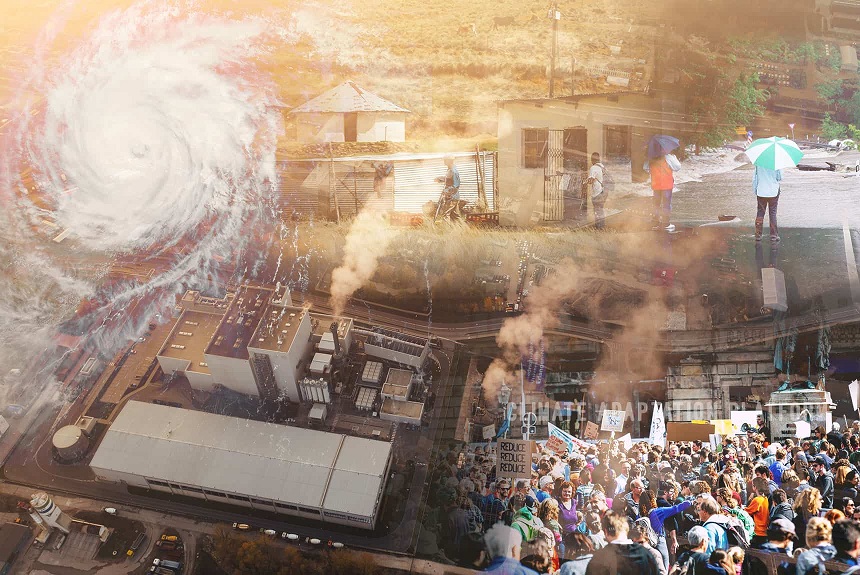Introduction
Climate change poses a significant threat to urban areas worldwide. Cities, which are home to over half of the global population, are particularly vulnerable due to their high population density, infrastructure concentration, and economic activities. As the impacts of climate change become increasingly evident—rising temperatures, increased frequency and severity of extreme weather events, and sea-level rise—it is imperative for urban areas to develop and implement effective adaptation strategies. This essay explores the necessity of climate change adaptation in urban areas, key strategies for adaptation, and the implications of these strategies for urban planning and policy.

Necessity of Climate Change Adaptation in Urban Areas
- Increased Vulnerability to Extreme Weather Events
Urban areas are particularly susceptible to the adverse effects of extreme weather events such as hurricanes, floods, and heatwaves. The concentration of infrastructure, assets, and people amplifies the potential for widespread damage and disruption. For instance, flooding can overwhelm drainage systems, disrupt transportation networks, and displace large numbers of residents. - Rising Temperatures and Heat Islands
Cities often experience higher temperatures than their rural surroundings due to the urban heat island effect, caused by extensive concrete and asphalt surfaces that absorb and retain heat. Rising temperatures can exacerbate this effect, leading to health risks such as heat stress and increased mortality, particularly among vulnerable populations like the elderly and those with pre-existing health conditions. - Sea-Level Rise and Coastal Cities
Many major cities are located along coastlines, making them vulnerable to sea-level rise and storm surges. Coastal flooding can lead to the loss of property, infrastructure damage, and displacement of communities. Proactive adaptation measures are essential to mitigate these risks and protect coastal urban areas.
Key Strategies for Climate Change Adaptation
- Green Infrastructure and Nature-Based Solutions
Incorporating green infrastructure, such as parks, green roofs, and urban forests, can help mitigate the impacts of climate change. These nature-based solutions can reduce heat islands, improve air quality, and manage stormwater runoff. For example, green roofs can absorb rainwater, reduce the burden on drainage systems, and provide insulation, lowering energy consumption. - Resilient Urban Planning and Design
Urban planning must integrate climate resilience by designing buildings and infrastructure that can withstand extreme weather events. This includes elevating structures in flood-prone areas, reinforcing buildings to resist high winds, and designing drainage systems that can handle increased rainfall. Zoning regulations can also prevent development in high-risk areas. - Sustainable Water Management
Efficient water management is crucial for climate adaptation in urban areas. Cities can implement strategies such as rainwater harvesting, greywater recycling, and the creation of permeable surfaces to reduce runoff and enhance groundwater recharge. Additionally, upgrading aging water infrastructure can prevent leaks and ensure a reliable supply during droughts. - Early Warning Systems and Emergency Preparedness
Developing robust early warning systems and emergency response plans is essential for protecting urban populations during extreme weather events. These systems can provide timely information to residents, enabling them to take protective measures. Emergency preparedness plans should include evacuation routes, shelters, and resources for rapid response and recovery. - Community Engagement and Education
Engaging communities in climate adaptation efforts is vital for their success. Public awareness campaigns and educational programs can inform residents about the risks of climate change and the actions they can take to mitigate these risks. Involving communities in planning processes ensures that adaptation strategies are tailored to local needs and conditions.
Implications for Urban Planning and Policy
- Integrated and Holistic Approach
Effective climate change adaptation requires an integrated approach that considers the interconnections between various urban systems. Urban planners and policymakers must collaborate across sectors, including transportation, housing, water management, and public health, to develop comprehensive adaptation strategies. - Equity and Inclusivity
Adaptation measures must address the needs of all urban residents, particularly vulnerable and marginalized communities. Policies should ensure equitable access to resources and opportunities for participation in decision-making processes. Addressing social inequities can enhance community resilience and foster social cohesion. - Innovation and Technology
Advancements in technology can play a critical role in climate adaptation. Smart city technologies, such as sensors and data analytics, can monitor environmental conditions and inform adaptive responses. Investment in research and development can lead to innovative solutions for building climate resilience. - Policy and Regulatory Frameworks
Governments must establish and enforce policies and regulations that promote climate adaptation. This includes updating building codes, land-use plans, and environmental regulations to incorporate climate resilience. Financial incentives, such as grants and tax credits, can encourage the adoption of adaptive practices. - Long-Term Planning and Investment
Climate change adaptation requires long-term planning and sustained investment. Cities must prioritize funding for adaptation projects and seek innovative financing mechanisms, such as public-private partnerships and green bonds. Long-term planning should also incorporate adaptive management, allowing for flexibility and adjustments as conditions change.
Conclusion
Climate change adaptation is crucial for safeguarding urban areas against the escalating impacts of climate change. By implementing strategies such as green infrastructure, resilient urban planning, sustainable water management, and community engagement, cities can enhance their resilience and protect their residents. Urban planners and policymakers must adopt an integrated, equitable, and forward-thinking approach to ensure that urban areas remain livable, sustainable, and thriving in the face of climate change.




